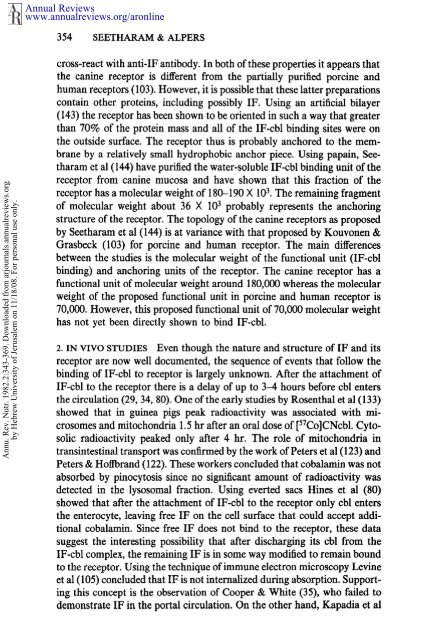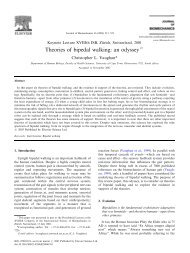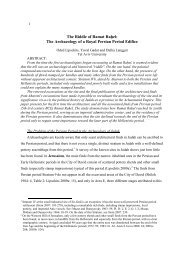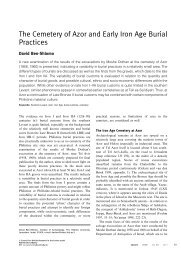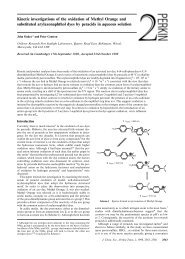Absorption and Transport of Cobalamin (Vitamin B12)
Absorption and Transport of Cobalamin (Vitamin B12)
Absorption and Transport of Cobalamin (Vitamin B12)
Create successful ePaper yourself
Turn your PDF publications into a flip-book with our unique Google optimized e-Paper software.
Annual Reviewswww.annualreviews.org/aronline354 SEETHARAM & ALPERSAnnu. Rev. Nutr. 1982.2:343-369. Downloaded from arjournals.annualreviews.orgby Hebrew University <strong>of</strong> Jerusalem on 11/18/08. For personal use only.cross-react with anti-IF antibody. In both <strong>of</strong> these properties it appears thatthe canine receptor is different from the partially purified porcine <strong>and</strong>human receptors (103). However, it is possible that these latter preparationscontain other proteins, including possibly IF. Using an artificial bilayer(143) the receptor has been shown to be oriented in such a way that greaterthan 70% <strong>of</strong> the protein mass <strong>and</strong> all <strong>of</strong> the IF-cbl binding sites were onthe outside surface. The receptor thus is probably anchored to the membraneby a relatively small hydrophobic anchor piece. Using papain, Seetharamet al (144) have purified the water-soluble IF-cbl binding unit <strong>of</strong> thereceptor from canine mucosa <strong>and</strong> have shown that this fraction <strong>of</strong> thereceptor has a molecular weight <strong>of</strong> 180-190 X 103. The remaining fragment<strong>of</strong> molecular weight about 36 × 103 probably represents the anchoringstructure <strong>of</strong> the receptor. The topology <strong>of</strong> the canine receptors as proposedby Seetharam et al (144) is at variance with that proposed by KouvonenGrasbeck (103) for porcine <strong>and</strong> human receptor. The main differencesbetween the studies is the molecular weight <strong>of</strong> the functional unit (IF-cblbinding) <strong>and</strong> anchoring units <strong>of</strong> the receptor. The canine receptor hasfunctional unit <strong>of</strong> molecular weight around 180,000 whereas the molecularweight <strong>of</strong> the proposed functional unit in porcine <strong>and</strong> human receptor is70,000. However, this proposed functional unit <strong>of</strong> 70,000 molecular weighthas not yet been directly shown to bind IF-cbl.2. IN VlVO STUDIES Even though the nature <strong>and</strong> structure <strong>of</strong> IF <strong>and</strong> itsreceptor are now well documented, the sequence <strong>of</strong> events that follow thebinding <strong>of</strong> IF-cbl to receptor is largely unknown. After the attachment <strong>of</strong>IF-cbl to the receptor there is a delay <strong>of</strong> up to 3-4 hours before cbl entersthe circulation (29, 34, 80). One <strong>of</strong> the early studies by Rosenthal et al (133)showed that in guinea pigs peak radioactivity was associated with microsomes<strong>and</strong> mitochondria 1.5 hr after an oral dose <strong>of</strong> [57Co]CNcbl. Cytosolicradioactivity peaked only after 4 hr. The role <strong>of</strong> mitochondria intransintestinal transport was confirmed by the work <strong>of</strong> Peters et al (123) <strong>and</strong>Peters & H<strong>of</strong>fbr<strong>and</strong> (122). These workers concluded that cobalamin was notabsorbed by pinocytosis since no significant amount <strong>of</strong> radioactivity wasdetected in the lysosomal fraction. Using evened sacs Hines et al (80)showed that after the attachment <strong>of</strong> IF-cbl to the receptor only ebl entersthe enterocyte, leaving free IF on the cell surface that could accept additionalcobalamin. Since free IF does not bind to the receptor, these datasuggest the interesting possibility that after discharging its cbl from theIF-cbl complex, the remaining IF is in some way modified to remain boundto the receptor. Using the technique <strong>of</strong> immun electron microscopy Levineet al (105) concluded that IF is not internalized during absorption. Supportingthis concept is the observation <strong>of</strong> Cooper & White (35), who faileddemonstrate IF in the portal circulation. On the other h<strong>and</strong>, Kapadia et al


